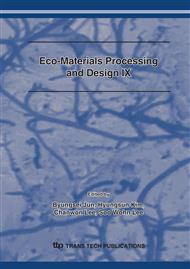p.17
p.21
p.25
p.29
p.33
p.37
p.41
p.45
p.49
Removal of Refractory Organic Compounds Using Peroxy Radical and Ozone Reaction in Aqueous Solution
Abstract:
This study was conducted to evaluate the treatment performance of the system using peroxy radical/ozone reaction for refractory organic compounds removal in aqueous solution. The effect of initial humic acid concentration was conducted under the conditions of humic acid concentration 10 mg/L, 30 mg/L, 50 mg/L and 100 mg/L. Reaction rate constant (k) in 30 mg/L of humic acid concentration was higher than that of humic acid concentration 10 mg/L, 50 mg/L amd 100 mg/L. However, it decreased over the range of 30 mg/L of humic acid concentration due to the action of internal filter of humic acid itself. Reaction rate constant (k) in the initial 20 minute of reaction time was accelerated by decreasing hydraulic retention time (HRT). This may be ascribed to increase the reaction time between peroxy radical and ozone. pH is a key for both ozone stability and TiO2 surface property in aqueous solution. Reaction rate constant (k) of acid solution on pH variation was smaller compared to that of neutral or basic circumstances because ozone decomposes easily into hydroxyl radicals in neutral or basic solution. At reaction rate constant (k) for humic acid degradation in each unit process, peroxy radical/ozone combined system was higher than that of ozone only due to the effective production of hydroxyl radical. An obvious difference between ozone and peroxy radical/ozone is the consequence of hydroxyl radical produced by the reaction of ozone molecules and peroxy radicals.
Info:
Periodical:
Pages:
33-36
Citation:
Online since:
January 2008
Authors:
Keywords:
Price:
Сopyright:
© 2008 Trans Tech Publications Ltd. All Rights Reserved
Share:
Citation:


